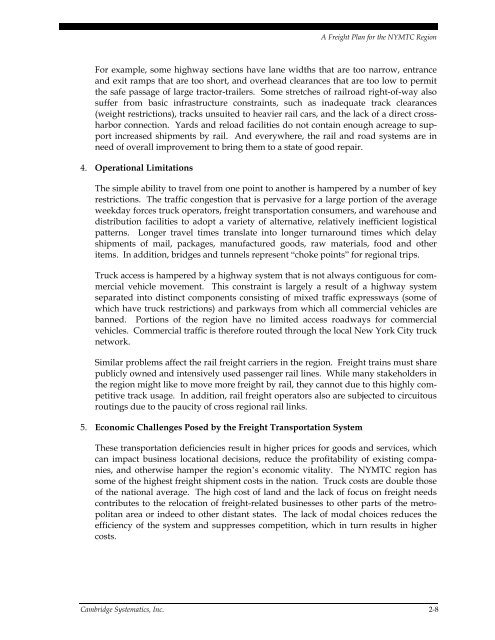nymtc regional freight plan - New York Metropolitan Transportation ...
nymtc regional freight plan - New York Metropolitan Transportation ...
nymtc regional freight plan - New York Metropolitan Transportation ...
Create successful ePaper yourself
Turn your PDF publications into a flip-book with our unique Google optimized e-Paper software.
A Freight Plan for the NYMTC Region<br />
For example, some highway sections have lane widths that are too narrow, entrance<br />
and exit ramps that are too short, and overhead clearances that are too low to permit<br />
the safe passage of large tractor-trailers. Some stretches of railroad right-of-way also<br />
suffer from basic infrastructure constraints, such as inadequate track clearances<br />
(weight restrictions), tracks unsuited to heavier rail cars, and the lack of a direct crossharbor<br />
connection. Yards and reload facilities do not contain enough acreage to support<br />
increased shipments by rail. And everywhere, the rail and road systems are in<br />
need of overall improvement to bring them to a state of good repair.<br />
4. Operational Limitations<br />
The simple ability to travel from one point to another is hampered by a number of key<br />
restrictions. The traffic congestion that is pervasive for a large portion of the average<br />
weekday forces truck operators, <strong>freight</strong> transportation consumers, and warehouse and<br />
distribution facilities to adopt a variety of alternative, relatively inefficient logistical<br />
patterns. Longer travel times translate into longer turnaround times which delay<br />
shipments of mail, packages, manufactured goods, raw materials, food and other<br />
items. In addition, bridges and tunnels represent “choke points” for <strong>regional</strong> trips.<br />
Truck access is hampered by a highway system that is not always contiguous for commercial<br />
vehicle movement. This constraint is largely a result of a highway system<br />
separated into distinct components consisting of mixed traffic expressways (some of<br />
which have truck restrictions) and parkways from which all commercial vehicles are<br />
banned. Portions of the region have no limited access roadways for commercial<br />
vehicles. Commercial traffic is therefore routed through the local <strong>New</strong> <strong>York</strong> City truck<br />
network.<br />
Similar problems affect the rail <strong>freight</strong> carriers in the region. Freight trains must share<br />
publicly owned and intensively used passenger rail lines. While many stakeholders in<br />
the region might like to move more <strong>freight</strong> by rail, they cannot due to this highly competitive<br />
track usage. In addition, rail <strong>freight</strong> operators also are subjected to circuitous<br />
routings due to the paucity of cross <strong>regional</strong> rail links.<br />
5. Economic Challenges Posed by the Freight <strong>Transportation</strong> System<br />
These transportation deficiencies result in higher prices for goods and services, which<br />
can impact business locational decisions, reduce the profitability of existing companies,<br />
and otherwise hamper the region’s economic vitality. The NYMTC region has<br />
some of the highest <strong>freight</strong> shipment costs in the nation. Truck costs are double those<br />
of the national average. The high cost of land and the lack of focus on <strong>freight</strong> needs<br />
contributes to the relocation of <strong>freight</strong>-related businesses to other parts of the metropolitan<br />
area or indeed to other distant states. The lack of modal choices reduces the<br />
efficiency of the system and suppresses competition, which in turn results in higher<br />
costs.<br />
Cambridge Systematics, Inc. 2-8

















